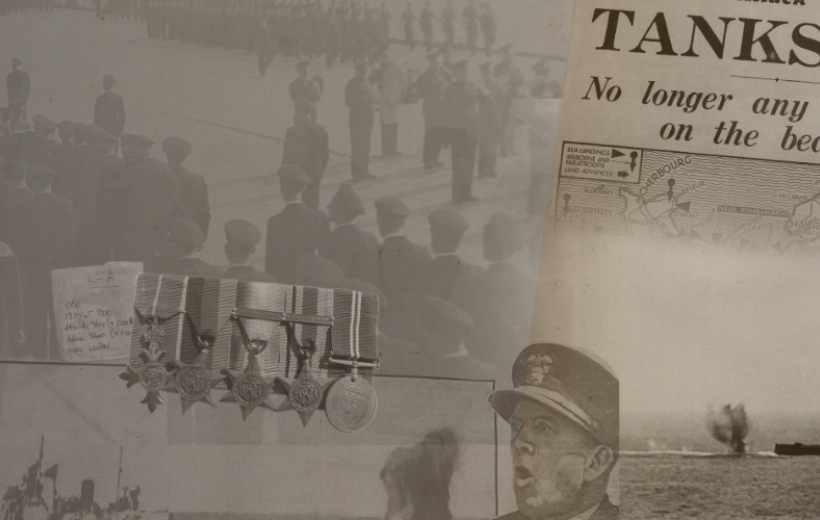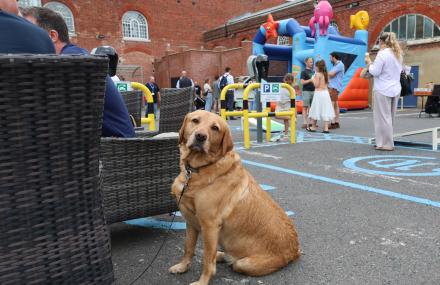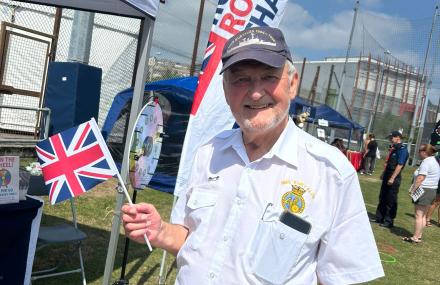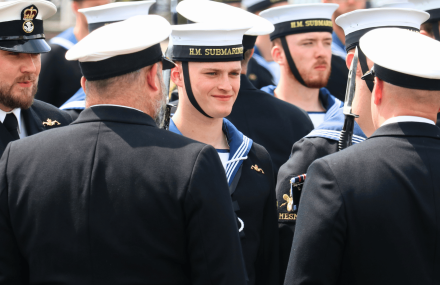If you would like to share your D-Day story, you can here
The invasion of Normandy to the average person was the greatest combined operation that had ever taken place, and that in fact was the truth. However, few people know of the work carried out by small, special units, both before the operation, and during the initial assaults. We were one of the small units which had this particular role to play. A role which was not easy, and from which many of us did not expect to return
Lieutenant Harold Hargreaves DSC RNVR
In the annals of naval history, Lieutenant Harold Hargreaves DSC RNVR, a cotton Salesman from Burnley, stands as a testament to courage, innovation, and the relentless pursuit of victory. His exploits in the realm of human torpedoes and midget submarines during World War II not only showcased his daring spirit but also contributed significantly to the evolution of naval tactics. Through the lens of seminal works like "Human Torpedoes and Midget Submarines" by C. E. T. Warren and James Benson, as well as "The Frogmen: The Story of the Wartime Underwater Operators" by James Joseph Gleeson and Thomas John Waldron, the remarkable story of Lieutenant Harold Hargreaves comes to life, weaving a narrative of bravery and ingenuity in the face of adversity.
Lieutenant Harold Hargreaves emerged as a key figure in the development and deployment of human torpedoes and midget submarines, a specialised craft designed for covert underwater operations. These unconventional vessels played a pivotal role in disrupting enemy naval operations and striking critical targets with stealth and precision. Hargreaves, with his remarkable leadership and technical acumen, became instrumental in training and leading teams of naval operatives tasked with operating these cutting-edge machines of war.
As a member of the Landing Clearance Units, Hargreaves would have been tasked with clearing obstacles and ensuring safe passage for Allied landing craft onto the beaches of Normandy. This involved hazardous work such as locating and neutralising underwater mines, demolishing enemy defences, and clearing obstacles like steel and concrete barriers that the Germans had erected to impede the Allied assault.
The first men ashore on "D" day were frogmen; this time they were called Landing Craft Obstacle Clearance Units [LCOCUs pronounced Lock-yews]. There were a hundred and twenty of them and their object was to clear away the underwater obstructions and mines so that the assault craft could get on to the beach.
The frogmen who blasted a hole in the Nazis' Atlantic Wall, and enabled invasion craft to reach the Normandy beaches on "D" day were nearly all "hostilities only" men. The men who led the units were Lt. R. E. Billington, D.S.C. and Bar, R.N.V.R., aged 28, of Purley; Lt. H. Hargreaves, D.S.C., aged 21, a cotton salesman from Burnley….”
This is what Lt. H. Hargreaves, D.S.C., the cotton salesman from Manchester, said about it:
"The invasion of Normandy to the average person was the greatest combined operation that had ever taken place, and that in fact was the truth. However, few people know of the work carried out by small, special units, both before the operation, and during the initial assaults. We were one of the small units which had this particular role to play. A role which was not easy, and from which many of us did not expect to return, but one which we were determined to carry out until our work was completed. For the invasion of Normandy the Force Commanders used approximately a hundred and twenty officers and men of the Locku units divided into ten parties, or units. Each unit had an officer and eleven men, and each was allotted to its own beach and had its own particular job to do. In my case, and that of a brother officer, we found ourselves detailed to deal with the obstacles on a beach near the village of La Riviere.
"We were supposed to go in at H hour, which was the very beginning of the assault. We were dropped into our craft from an L.S.I. at seven o'clock in the morning and went hell-for-leather for the beach, and arrived hoping to find the front row of obstacles on the water's edge, and not in the water, but discovered some two or three feet of water over them. We left our craft and got to work at once on posts with mines secured to the tops of them, specially constructed wooden ramps which were mined, and steel hedgehogs with mines and anti-aircraft shells on top of them, and we were subjected the whole time to quite a hot fire from rockets, shells and bombs.
"We must have been about four hundred yards from the beach when the firing first started, and they didn't forget to inform us that they knew we were coming. When we finally got on the beach we discovered that we were being systematically sniped, not only with rifles but also by odd bursts of machine-gun fire - a most unpleasant experience - but one that we soon got used to. As time went on we almost forgot about it until we realised that opposition was dying down because in the meantime the Army had landed and was dealing with machine-gun posts, mortar posts, and all the other unpleasant places Jerry had prepared for us.
"The weather was very much worse than anyone would have expected in June, and we had the greatest difficulty working in a very heavy surf. It was hard going and we soon got pretty tired, but in the meantime the obstacles were being slowly but systematically destroyed. As we made an initial gap for the landing craft to come through, so we increased the size of the gap as time went on. We succeeded in clearing the whole of the beach some thousand yards in length, with obstacles going out to over four hundred yards by the end of "D" day.
"That didn't end our work, of course, although the worst was over. Landing craft of all shapes and sizes were simply pouring on to the beach, and in the meantime, having cleared that beach, we had to proceed to another beach and get rid of the obstacles there. In all, we successfully disposed of over two thousand five hundred obstacles, practically every one mined, in addition to this, as a sort of savoury, we cleared the explosives out of half a dozen beetle tanks.
"Not long before 'D' day a special jacket had been invented to protect us against that terrible blast which can be experienced when a mine or shell explodes underwater. This jacket was known as a 'Kapok Jacket' and was worn underneath our swim suits. It proved to be a most wonderful thing, and saved the lives of no less than three of my men. One of my petty officers, who was working in about six feet of water, had a shell or mortar bomb explode in the water quite close to him, and although he was completely knocked out, and in fact paralysed for several hours, he had no injuries whatever, and no after effects. A Royal Engineer who was swimming towards the beach from one of the landing craft, and was some distance farther away from the explosion than the petty officer, was killed outright, and I have no doubt that many men suffered the same fate on that day.
"I would like to make it quite clear that we don't in any way look upon ourselves as supermen, or heroes, or anything like that at all, and we did not by any means clear all the obstacles off the beaches in time for the landing craft to get in. There were nowhere near enough of us to have hoped to do it. What we could, and did do, was to clear an initial gap for the landing craft to beach safely, and to increase that gap as quickly as possible until the beach was entirely free from obstacles.
"Consequently many of the landing craft who didn't use the gap, because of the simple fact that there just wasn't room for them, struck obstacles, or had holes blown in them or their bottoms torn out, with the result that many men had to swim ashore with full equipment.
"When our original job had been completed we had to keep our reputation as 'Jack the Handyman' by doing many jobs to assist on the beaches, such as winching drowned vehicles out of the water. We did this by taking a wire with a hook on the end, right out to sea in our swim suits and breathing sets, hook up the vehicle, come to the surface and signal to the operator ashore to start up his winch, which he did, and pulled the drowned vehicle up high and dry. We helped to unload stores, we cleared mines, we assisted the Royal Engineers, in fact we did everything except mind the babies, and if there had been any there we would have done that too.”
"Throughout the landings, in all ten units, the total casualties were two frogmen killed and ten wounded - some seriously. Lt. Hargreaves was wounded in the shoulder, but carried on. One of the coolest pieces of work was done by Sgt. K. Briggs, D.S.M., R.M., who, although he was being sniped at all the time, rendered a hundred charges safe, single-handed."
The legacy of Lieutenant Harold Hargreaves extends beyond his wartime achievements, resonating through the generations of naval warfare. His grandson, Lieutenant Nicholas Hargreaves RNR (Royal Navy Reserve) , Mine Warfare, 1st Lieutenant at HMS Eaglet, embodies the spirit of service and innovation that defined his grandfather's legacy. Through the passage of time, the torch of valour has been passed down, inspiring future generations to uphold the proud tradition of naval excellence.
As Lieutenant Nicholas Hargreaves continues to serve, his lineage serves as a living testament to the enduring legacy of Lieutenant Harold Hargreaves DSC RNVR, who’s indelible mark on naval history stands as a testament to the transformative power of human ingenuity in the face of adversity. Through his pioneering efforts in the realm of human torpedoes and midget submarines, he reshaped the landscape of naval warfare and inspired future generations to push the boundaries of innovation. As his grandson Lieutenant Nicholas Hargreaves RNR carries forth the family legacy, the Hargreaves name remains etched in the annals of naval valour, a beacon of inspiration for all who follow in their wake.










